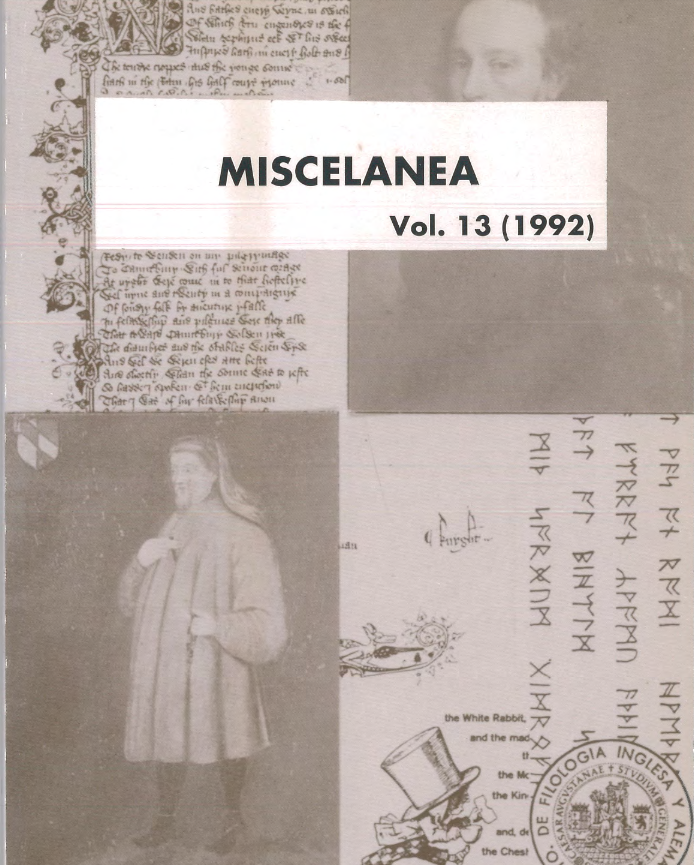How to Provide Functional Grammar with Typological-Diachronic Adequacy
DOI:
https://doi.org/10.26754/ojs_misc/mj.199211803Abstract
The purpose of this paper is to discuss how the theory of Functional Grammar as stated by Dik (1979 and 1989) can be provided with Typological-Diachronic Adequacy. The reason why this new concept is coined is that, in spite of the fact that one of the main concerns of Functional Grammar is how to achieve typological adequacy (more than eighty languages —most of which are not Indo-uropean— have been successfully discussed from the point of view of FG), this theoretical framework still lacks a detailed discussion of the relationship between Diachrony and Typology.
This paper revises critically the standards of adequacy proposed byTransformational Grammar and compares them with the ones put forward in the realm of Functional Grammar. In doing so, we concentrate on the specifications forDescriptive Adequacy and pay special attention to these specifications in FG. Then, after revising the constraints imposed on the power of FG , we define and explain the new concept which is proposed here: TypologicalDiachronic Adequacy. Afterwards, we go on to discuss how to provide Dik's Functional Grammar with Typological-Diachronic Adequacy and, finally, we answer the question whether or not new |constraints upon the descriptive power of the theory arise.
Display downloads
References
BOSSUYT, A. 1986. “Functional Requirements. Causes or Constraints upon Language Change?" Belgian Journal of Linguistics 1: 127-147. DOI: https://doi.org/10.1075/bjl.1.06bos
BUTLER, C. 1990.. “Functional Grammar and Systemic Grammar: A Preliminary Discussion." Working Papers in Functional Grammar 39. Amsterdam: University of Amsterdam.
CHOMSKY, N. 1957. Syntactic Structures. The Hague: Mouton. DOI: https://doi.org/10.1515/9783112316009
---. 1965. Aspects of the Theory of Syntax. Cambridge (MA): MIT Press.
---. 1977. Essays on Form and Interpretation. Amsterdam: North Holland,
---. 1981. Lectures on Government and Binding. Dordrecht: Foris.
---. 1982. Some Concepts and Consequences of the Theory of Government and Binding. "Cambridge (MA): MIT Press.
---. 1986. Knowledge of language: Its Nature, Origin and Use. New York: Praeger.
COMRIE, B. 1981. language Universals and Language Typology. Oxford: Blackwell.
CONOQLLY, J. H, and S. C. Dik, eds. 1990. Functional Grammar and the Computer Dordrecht: Foris Publications.
CROFT, W. 1990. Typology and Universals. Cambridge: Cambridge UP.
DIK, S. C. 1978. Stepwise Lexical Decomposition. lisse: De Ridder.
---. 1979, Functional Grammar. Dordrecht: Foris.
---. 1986a. “On the Notion Functional Explanation.” Belgian Journal of Linguistics 1: 11-52. DOI: https://doi.org/10.1075/bjl.1.02dik
---. 1986b. “Linguistically Motivated Knowledge Representation.” Working Papers in Functional Grammar 9. Amsterdam: U of Amsterdam.
---. 1986c. “Functional Grammar and its Potencial Computer Applications.” Working Papers in Functional Grammar 18. Amsterdam: U of Amsterdam.
---. 1989. The Theory of Functional Grammar. Part |: The Simple Clause. Dordrecht: Foris.
---. 1990. “Relational Reasoning in Functional Logic”, in J.H. Conolly and S.C. Dik,.eds. 1990: 273-288. DOI: https://doi.org/10.1515/9783110871685-016
DIK, S. C., and K. Hengeveld. 1990, “The hierarchical structure of the clause and the typology of perception verb complements.” Working Papers in Functional Grammar 37. Amsterdam: U of Amsterdam,
GEERAERTS, D. 1986. “Functional Explanations in Diachronic Semantics.” Belgian Journal of Linguistics 1: 67-93. DOI: https://doi.org/10.1075/bjl.1.04gee
GIVON, T. 1984. Syntax: A Functional-Typological Introduction. Amsterdam: Benjamins. DOI: https://doi.org/10.1075/z.17
GREENBERG, J. ed. (1963) 1966. Universals of language. Cambridge (MA): M.LT. Press.
---. 1978. Universals of Human Language. 4 vols. Stanford: Stanford UP.
HENGEVELD, K. 1988. “Layers and Operators in Functional Grammar.” Working Papers in Functional Grammar 27. Amsterdam: U of Amsterdam.
HORROCKS, G. 1987. Generative Grammar. London: Longman.
KEFER, M. 1986. “On Functional Explanations of language Change, Universals and Rules.” Belgian Journal of linguistics 1: 53-66. DOI: https://doi.org/10.1075/bjl.1.03kef
MARTIN MINGORANCE, L. 1988. “Léxico y sintaxis en la Gramática Funcional de S.C. Dik.” Actas de las I Jornadas de Lengua y Literatura Inglesa. Logroño: Colegio Universitario de la Rioja.
MEIJS, W. J. 1990. “Spreading the Word: Knowledge-Activation in a Functional Perspective.” In J. H. Conolly and S. C. Dik, eds. 1990: 201-215. DOI: https://doi.org/10.1515/9783110871685-012
MILLER, P. 1986. “On Certain Formal Properties of Dik's Functional Grammar.” Belgian Journal of linguistics 1:171-221. DOI: https://doi.org/10.1075/bjl.1.08mil
NUYTS, J. 1986. “What Formalists Seem Not to Understand About Functionalism.” Belgian Journal of Linguistics 1: 223-237. DOI: https://doi.org/10.1075/bjl.1.09nuy
RADFORD, A. 1988. Transformational Grammar. Cambridge: Cambridge University Press. DOI: https://doi.org/10.1017/CBO9780511840425
RIKHOFF, J. 1986. “Word Order Revisited. The Principle of Head Proximity.” Belgian Journal of Linguistics 1: 95-125. DOI: https://doi.org/10.1075/bjl.1.05rij
Downloads
Published
Issue
Section
License
Copyright (c) 1992 Javier Martín Arista

This work is licensed under a Creative Commons Attribution-NonCommercial 4.0 International License.


